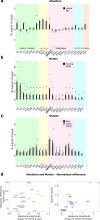The human endogenous attentional control network includes a ventro-temporal cortical node
- PMID: 33452252
- PMCID: PMC7810878
- DOI: 10.1038/s41467-020-20583-5
The human endogenous attentional control network includes a ventro-temporal cortical node
Abstract
Endogenous attention is the cognitive function that selects the relevant pieces of sensory information to achieve goals and it is known to be controlled by dorsal fronto-parietal brain areas. Here we expand this notion by identifying a control attention area located in the temporal lobe. By combining a demanding behavioral paradigm with functional neuroimaging and diffusion tractography, we show that like fronto-parietal attentional areas, the human posterior inferotemporal cortex exhibits significant attentional modulatory activity. This area is functionally distinct from surrounding cortical areas, and is directly connected to parietal and frontal attentional regions. These results show that attentional control spans three cortical lobes and overarches large distances through fiber pathways that run orthogonally to the dominant anterior-posterior axes of sensory processing, thus suggesting a different organizing principle for cognitive control.
Conflict of interest statement
The authors declare no competing interests.
Figures








References
-
- Goldstein, B., Chun, M. M. & Wolfe, J. M. “Visual attention” in Blackwell Handbook of Perception, (ed. Goldstein, B. E.) pp. 272–310 (Blackwell Publishers Ltd., Oxford, UK, 2001).
-
- Heilman KM, Valenstein E. Frontal lobe neglect in man. Neurology. 1972;22:660–664. - PubMed
-
- Heilman KM, Watson RT, Bower D, Valenstein E. Right hemisphere dominance for attention. Rev. Neurol. 1983;139:15–17. - PubMed
-
- Vallar G, Perani D. The anatomy of unilateral neglect after right-hemisphere stroke lesions. A clinical/CT-scan correlation study in man. Neuropsychologia. 1986;24:609–622. - PubMed
-
- Mort DJ, et al. The anatomy of visual neglect. Brain. 2003;126:1986–1997. - PubMed
Publication types
MeSH terms
Grants and funding
LinkOut - more resources
Full Text Sources
Other Literature Sources

